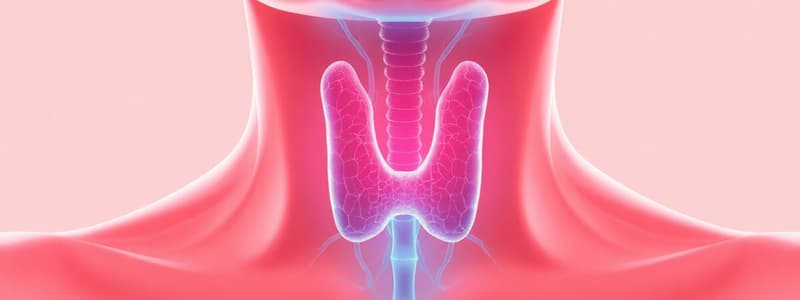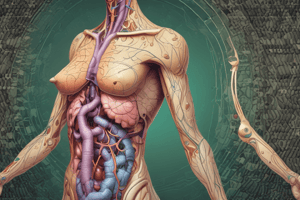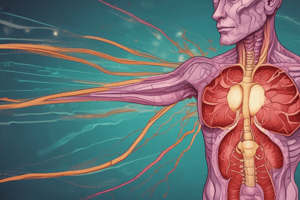Podcast
Questions and Answers
Thyroid hormones are derived from the amino acid phenylalanine.
Thyroid hormones are derived from the amino acid phenylalanine.
False
The main function of the thyroid gland is the synthesis and storage of thyroid hormone.
The main function of the thyroid gland is the synthesis and storage of thyroid hormone.
True
Thyroid stimulating hormone (TSH) is produced by the thyroid gland itself.
Thyroid stimulating hormone (TSH) is produced by the thyroid gland itself.
False
Colloid makes up approximately 30% of the mass of the thyroid gland and contains thyroglobulin.
Colloid makes up approximately 30% of the mass of the thyroid gland and contains thyroglobulin.
Signup and view all the answers
The apical surface of the follicular cell is responsible for hormone release into the bloodstream.
The apical surface of the follicular cell is responsible for hormone release into the bloodstream.
Signup and view all the answers
Iodine, required for thyroid hormone synthesis, is obtained from the circulation.
Iodine, required for thyroid hormone synthesis, is obtained from the circulation.
Signup and view all the answers
Parafollicular or C cells in the thyroid gland produce thyroid hormones.
Parafollicular or C cells in the thyroid gland produce thyroid hormones.
Signup and view all the answers
Thyroid hormones play a role exclusively in energy storage.
Thyroid hormones play a role exclusively in energy storage.
Signup and view all the answers
The secretion of thyroid hormones is regulated by thyrotropin-releasing hormone (TRH).
The secretion of thyroid hormones is regulated by thyrotropin-releasing hormone (TRH).
Signup and view all the answers
Lymphocytes are the only type of cells found in the thyroid gland.
Lymphocytes are the only type of cells found in the thyroid gland.
Signup and view all the answers
The human chorionic gonadotropin (hCG) does not bind to the TSH receptor and has no effect on thyroid function.
The human chorionic gonadotropin (hCG) does not bind to the TSH receptor and has no effect on thyroid function.
Signup and view all the answers
Thyroid hormones T3 and T4 are synthesized from diiodotyrosine and triiodotyrosine through a series of coupling reactions.
Thyroid hormones T3 and T4 are synthesized from diiodotyrosine and triiodotyrosine through a series of coupling reactions.
Signup and view all the answers
The primary action of TSH is to regulate the uptake of nutrients and promote cell apoptosis in thyroid cells.
The primary action of TSH is to regulate the uptake of nutrients and promote cell apoptosis in thyroid cells.
Signup and view all the answers
The process of iodide oxidation is primarily facilitated by the enzyme iodine oxidase.
The process of iodide oxidation is primarily facilitated by the enzyme iodine oxidase.
Signup and view all the answers
About 3/4 of the iodinated tyrosine in thyroglobulin is converted to thyroid hormones.
About 3/4 of the iodinated tyrosine in thyroglobulin is converted to thyroid hormones.
Signup and view all the answers
Iodide is transported into the follicular cell via a sodium/iodide symporter that moves two Na+ ions for each iodide molecule.
Iodide is transported into the follicular cell via a sodium/iodide symporter that moves two Na+ ions for each iodide molecule.
Signup and view all the answers
The thyroid gland can store sufficient thyroid hormones to meet physiological demands for approximately 6 months.
The thyroid gland can store sufficient thyroid hormones to meet physiological demands for approximately 6 months.
Signup and view all the answers
Thyroid hormone receptors are located exclusively in the nucleus of the cell.
Thyroid hormone receptors are located exclusively in the nucleus of the cell.
Signup and view all the answers
Reverse T3 (RT3) is synthesized from the coupling of diiodotyrosine and monoiodotyrosine, which is believed to be functionally significant in humans.
Reverse T3 (RT3) is synthesized from the coupling of diiodotyrosine and monoiodotyrosine, which is believed to be functionally significant in humans.
Signup and view all the answers
The Wolff-Chaikoff effect refers to increased organification of iodine when plasma iodide levels are elevated.
The Wolff-Chaikoff effect refers to increased organification of iodine when plasma iodide levels are elevated.
Signup and view all the answers
Thyroxine and triiodothyronine bind poorly with intracellular proteins compared to thyroxine-binding globulin.
Thyroxine and triiodothyronine bind poorly with intracellular proteins compared to thyroxine-binding globulin.
Signup and view all the answers
TSH is primarily stimulated by T3 in a feedback regulation.
TSH is primarily stimulated by T3 in a feedback regulation.
Signup and view all the answers
Thyroglobulin molecules can contain up to 30 thyroxine molecules and a few triiodothyronine molecules.
Thyroglobulin molecules can contain up to 30 thyroxine molecules and a few triiodothyronine molecules.
Signup and view all the answers
Thyroid hormones have no significant effect on cholesterol synthesis.
Thyroid hormones have no significant effect on cholesterol synthesis.
Signup and view all the answers
The conversion of iodide ions to an oxidized form of iodine is an early effect of TSH binding to its receptor.
The conversion of iodide ions to an oxidized form of iodine is an early effect of TSH binding to its receptor.
Signup and view all the answers
Hypothyroidism can result from reduced responsiveness of tissues to thyroid hormones, a condition known as thyroid hormone resistance.
Hypothyroidism can result from reduced responsiveness of tissues to thyroid hormones, a condition known as thyroid hormone resistance.
Signup and view all the answers
Epinephrine-induced glycogenolysis and insulin-induced glycogen synthesis are facilitated by thyroid hormones.
Epinephrine-induced glycogenolysis and insulin-induced glycogen synthesis are facilitated by thyroid hormones.
Signup and view all the answers
In adults, excess thyroid hormone levels can decrease the risk of osteoporosis.
In adults, excess thyroid hormone levels can decrease the risk of osteoporosis.
Signup and view all the answers
The main proteins that thyroxine binds to in the blood are synthesized by the spleen.
The main proteins that thyroxine binds to in the blood are synthesized by the spleen.
Signup and view all the answers
Thyroid hormone is essential for bone development and affects osteoclast and osteoblast activity.
Thyroid hormone is essential for bone development and affects osteoclast and osteoblast activity.
Signup and view all the answers
Hyperthyroidism is characterized by decreased basal metabolism and an underactive autonomic nervous system.
Hyperthyroidism is characterized by decreased basal metabolism and an underactive autonomic nervous system.
Signup and view all the answers
Graves disease is an autoimmune condition that results from TSH receptor stimulation by immunoglobulin G.
Graves disease is an autoimmune condition that results from TSH receptor stimulation by immunoglobulin G.
Signup and view all the answers
The thyroid-resistant state is marked by low levels of TSH despite high circulating free thyroid hormone levels.
The thyroid-resistant state is marked by low levels of TSH despite high circulating free thyroid hormone levels.
Signup and view all the answers
Exophthalmos occurs in approximately 40%–50% of patients with hyperthyroidism but is not related to Graves disease.
Exophthalmos occurs in approximately 40%–50% of patients with hyperthyroidism but is not related to Graves disease.
Signup and view all the answers
Toxic adenoma is one of the common causes of hyperthyroidism, along with Graves disease.
Toxic adenoma is one of the common causes of hyperthyroidism, along with Graves disease.
Signup and view all the answers
The incidence of Graves disease peaks in the aged population and is statistically equal among men and women.
The incidence of Graves disease peaks in the aged population and is statistically equal among men and women.
Signup and view all the answers
TSH producing tumors of the pituitary can result in hyperthyroidism.
TSH producing tumors of the pituitary can result in hyperthyroidism.
Signup and view all the answers
Hyaluronate accumulation in extraocular tissues is linked to the pathogenesis of exophthalmos.
Hyaluronate accumulation in extraocular tissues is linked to the pathogenesis of exophthalmos.
Signup and view all the answers
Individuals with thyroid ophthalmopathy often do not have any form of hyperthyroidism.
Individuals with thyroid ophthalmopathy often do not have any form of hyperthyroidism.
Signup and view all the answers
Excess iodine intake is a rare cause of hyperthyroidism.
Excess iodine intake is a rare cause of hyperthyroidism.
Signup and view all the answers
Study Notes
Thyroid Gland: Structure, Function, and Disorders
- Thyroid hormones (T3, T4) regulate energy homeostasis and cell metabolism, crucial for development and maturation. Deficiencies cause severe mental retardation in infants.
- Thyroid hormones are derived from tyrosine and produced by the thyroid gland. Production is stimulated by TSH from the anterior pituitary, which is itself regulated by TRH.
- Dietary iodine is also essential for thyroid hormone production.
- The thyroid gland's functional unit is the thyroid follicle, composed of follicular cells surrounding a colloid-filled cavity. Colloid contains thyroglobulin (Tg).
- Follicular cells are polarized: the apical side faces the colloid, where thyroglobulin iodination occurs, and the basolateral side faces the circulation for hormone release.
- TSH regulates nutrient uptake and intracellular transport of proteins involved in thyroid hormone synthesis and release. This includes proteins like Na+/I- symporter, Tg, TPO (thyroid peroxidase), and thyroid hormones themselves.
- TSH also stimulates gene transcription of these proteins.
- Iodide is actively transported into follicular cells by the Na+/I− symporter. This process requires energy and is crucial for thyroid hormone production.
- Iodide is subsequently oxidized and incorporated into tyrosine residues within thyroglobulin.
Thyroid Hormone Synthesis
- Thyroid hormones are synthesized by the organification of thyroglobulin. Iodine is incorporated by thyroid peroxidase.
- Iodinated tyrosine molecules (monoiodotyrosine, diiodotyrosine) couple to form T4 (thyroxine) and smaller amounts of T3 (triiodothyronine).
- Tg containing hormones are stored in the colloid. The thyroid gland stores sufficient hormones for several months.
- Thyroid hormone release is triggered by endocytosis of colloid into the follicular cell. Lysosomal digestion frees T3 and T4.
Thyroid Hormone Transport and Action
- More than 99% of T4 and T3 bind to plasma proteins (primarily thyroxine-binding globulin). This slow, controlled release of hormones to tissues is important.
- T4 is converted to the more active T3 intracellularly.
- Thyroid hormone receptors are found within virtually all tissues. T3 binds to these receptors, activating nuclear transcription of many genes, including those for metabolic enzymes. This results in increased oxygen consumption, fatty acid oxidation, and protein synthesis.
- Thyroid hormones also regulate various organ-specific functions.
Effects on Various Organs
- Bone: Essential for bone growth and development.
- Cardiovascular: Increases cardiac output and blood volume, decreases systemic resistance.
- Adipose tissue: Regulates lipolysis (breaking down fats).
- Liver: Regulates triglyceride and cholesterol metabolism.
- Pituitary: Regulates pituitary hormone synthesis.
- Brain: Crucial roles in myelination, cell differentiation, migration, and signaling.
- Reproductive function: Essential for folliculogenesis, granulosa cell survival, spermatogenesis, fertilization, placental function, and gestation.
Thyroid Disorders
- Hypothyroidism: Insufficient thyroid hormone action, may result from primary or secondary causes. Severe cases in infancy can cause cretinism.
- Hyperthyroidism: Excessive thyroid hormone production. Causes include Graves' disease (autoimmune), toxic nodular goiter, and toxic adenoma.
- Wolff-Chaikoff effect: High plasma iodide levels inhibit the organic binding of iodine within the thyroid.
- Graves' disease: An autoimmune condition causing excess thyroid hormone production due to antibodies mimicking TSH. Often characterized by exophthalmos (protruding eyes).
Studying That Suits You
Use AI to generate personalized quizzes and flashcards to suit your learning preferences.
Description
This quiz delves into the structure, function, and disorders of the thyroid gland. It covers essential topics such as thyroid hormones, their regulation, and the impact of dietary iodine. Test your understanding of the thyroid's role in metabolism and development.





